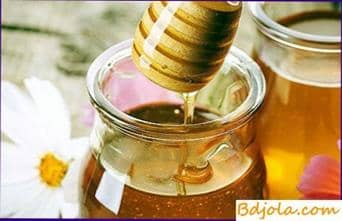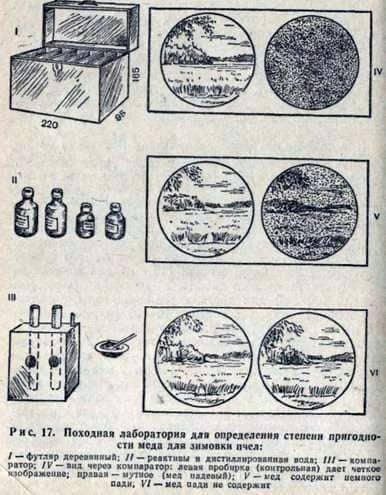Determination of the suitability of honeydew honey for the wintering of bees
 Determine the suitability of honey for the wintering of bees can be one of the following ways.
Determine the suitability of honey for the wintering of bees can be one of the following ways.
Lime reaction. First prepare the lime water. To do this, the glass jar is half filled with ordinary slaked lime and poured to the top with distilled or rainwater. The mixture is thoroughly stirred, after which it is allowed to stand. In the upper part of the jar a clear liquid is formed, which is carefully drained off; this will be lime water.
To test honey on a drop in a test tube, place about one volume part of honey, add as much distilled water and shake well. Then add as much (how much was diluted honey) of lime water, shake well and heat to a boil. Honey pomade gives a flocculent deposit. The more fall in honey, the more will be sediment. For control, the same reaction is simultaneously carried out with benign floral honey.
Alcohol reaction. In a test tube, pour one part of honey, one part of distilled water, shake and add 8-10 parts of wine 96% alcohol. If there is a padi in the liquid, a turbidity is formed, which then settles on the bottom. It should be noted that buckwheat honey with alcohol forms the same turbidity and sediment as pade honey, so you can not use alcohol reaction in this case.
With the help of the marching laboratory of the Institute of Apiculture. This method allows you to establish not only the presence of a pad in honey, but also to find out whether honey is completely unfit for bees for the winter or can be left if the impurity is small. It is easy to make a field laboratory for the beekeeper.

For this purpose, the following equipment and reagents are purchased: a cup (porcelain or glass) with a capacity of 15-20 cm3, a bottle (15 cm3) for lead acetate dissolved in water, a bottle (15 cm3) for crystalline lead acetate, 2 bottles (each 100 cm3 capacity) for distilled water, a glass test tube
All listed items are included in a box with a lid, made of thin ДПУПЮЕЛ in length of 220 mm, width of 95 mm, height of 165 mm; The box is equipped with sockets for a stable position of each object.
In addition, a beaker or a measuring cylinder of 50 or 100 cm3 capacity is needed (it does not fit into the box, but is used only when preparing solutions). Of the reagents, crystalline acetate, distilled water and distilled water are needed.
The calibration of the tubes is carried out in the following manner. The test tube is weighed and then distilled water is poured into it (drops) until the mass of the tube is increased by 0.2 g. A small file is marked on the lower meniscus of water. Then add the water to the tube before increasing its mass by another 1.1 g. At this point make a second mark (1,3).
To prepare the solution for the standard take 3 cm3 of good flower honey, add 1 cm3 of distilled water to it and mix well. Then 50 cm3 of rectified alcohol (96%) was added to the solution and again thoroughly mixed. In a test tube of the standard, pour 3-5 cm3 of the resulting solution.
To prepare a solution of acetic acid lead, 3.7 g of this reagent is weighed, placed in a graduated cylinder and filled up to 15 cm3 with distilled water. The solution is well mixed, filtered and poured into a 15 cm3 vial; this amount of reagent is sufficient for 200-300 assays.
Determine the fall in honey as follows. Honey, taken for analysis, put in a cup and stirred with a glass rod. Then gently transfer the honey with drops to a small tube exactly to the first lower mark (0.2). The tube is held strictly vertically, so that the drops of honey fall to the bottom, without touching the walls. Then pipette is added to the test tube exactly to the second label (1,3). Honey with water is thoroughly mixed with a second glass rod until a homogeneous solution is obtained, which is then poured into a large test tube and placed in a comparator. In a small test tube, distilled water is again poured into the second label. After washing off the remaining honey, the contents are also poured into a large test tube and vigorously shaken.
To a solution of honey in a large tube add two drops of a reagent – a solution of acetic acid lead – from the pipette. After vigorous shaking, the tube is inserted into the comparator next to the test tube. In this case, the contents of the reference tube are also necessarily shaken.
The comparator is brought close to the eyes and looks through the horizontal openings to the solutions. Through the solution of the reference tube, the objects in the field of view of the observer are clearly visible. The turbidity of the solution in the second tube depends on the presence of a pad in the sample honey. The degree of turbidity of the solution is weakened by the addition of water dropwise (they need to be considered). After each addition of water, the contents of the tube are shaken. Water is added until the visibility through both tubes is the same. At the same time, they do not pay attention to the color of the solution.
If the number of added drops of water does not exceed 10, then such honey is considered quite suitable for the wintering of bees. If the number of water drops exceeds 60, then honey for wintering is unsuitable. With the number of drops from 10 to 60, honey can be used for wintering, but with a partial replacement with sugar.
Determination of the suitability of honeydew honey for the wintering of bees
